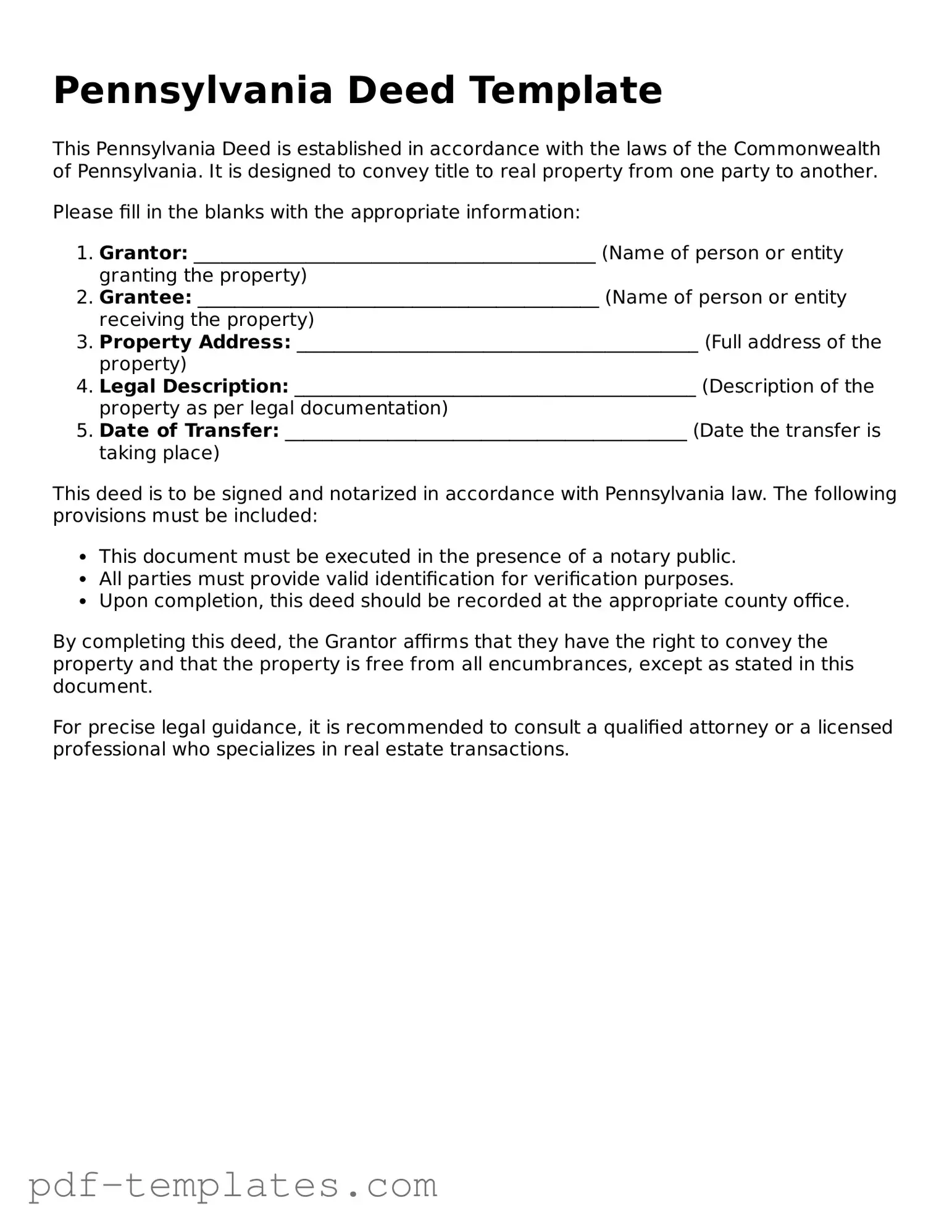The Pennsylvania Deed form is similar to the Quitclaim Deed. A Quitclaim Deed transfers ownership interest in a property from one party to another without guaranteeing that the title is clear. Like the Pennsylvania Deed, it requires signatures from the grantor and often needs to be notarized. However, it does not provide any warranties about the property’s title, making it a more straightforward, yet riskier, option for transferring property ownership.
Another document similar to the Pennsylvania Deed is the Warranty Deed. This type of deed offers a guarantee that the grantor holds clear title to the property and has the right to sell it. Like the Pennsylvania Deed, it requires the grantor's signature and must be recorded to be effective. The key difference lies in the warranties provided; the Warranty Deed assures the grantee that they will not face any claims against the property’s title.
The Bargain and Sale Deed is also comparable. This deed conveys property without any warranties against encumbrances. While it transfers ownership like the Pennsylvania Deed, it does not guarantee a clear title. The grantor’s signature is required, and recording the deed is essential for public notice. This type of deed is often used in transactions where the buyer is willing to accept the risk associated with potential title issues.
A Special Purpose Deed is another document that shares similarities with the Pennsylvania Deed. This type of deed is used for specific situations, such as transferring property from a trust or estate. Like the Pennsylvania Deed, it requires the grantor's signature and is recorded to ensure legal validity. However, it may include additional clauses that address the unique circumstances of the transfer.
The California Medical Power of Attorney form is a vital legal instrument that empowers individuals to designate a trusted person to make healthcare decisions on their behalf if they cannot express their wishes. This document ensures that a person's healthcare preferences are honored, even in situations where they are unable to communicate directly. By establishing a medical power of attorney, individuals can secure peace of mind knowing their health decisions are taken care of by someone they trust, making resources like All California Forms invaluable for understanding and executing these important legal procedures.
The Grant Deed is also akin to the Pennsylvania Deed. It conveys property ownership and includes some implied warranties, such as the assurance that the property has not been sold to anyone else. The Grant Deed requires the grantor's signature and must be recorded. While it provides some protection to the grantee, it does not offer the same level of assurance as a Warranty Deed.
The Deed of Trust is another document that resembles the Pennsylvania Deed. This document secures a loan by placing a lien on the property. While it serves a different primary purpose, it still involves the transfer of an interest in real estate. The Deed of Trust must be recorded, and it requires the signatures of the borrower, lender, and trustee. Unlike the Pennsylvania Deed, it does not transfer ownership but rather creates a security interest.
A Leasehold Deed is similar in that it involves the transfer of an interest in real estate, but it typically pertains to leasing rather than outright ownership. This document grants the lessee rights to use the property for a specified period. Like the Pennsylvania Deed, it requires signatures and may need to be recorded. The Leasehold Deed focuses on the terms of the lease rather than the transfer of ownership.
Finally, the Executor’s Deed is comparable as it is used to transfer property from a deceased person's estate. This document is executed by the executor of the estate and must be recorded to be effective. While it serves a specific purpose in estate administration, it shares the basic elements of a Pennsylvania Deed, including the need for signatures and public recording. The Executor’s Deed may also include specific language that addresses the authority of the executor to convey the property.
